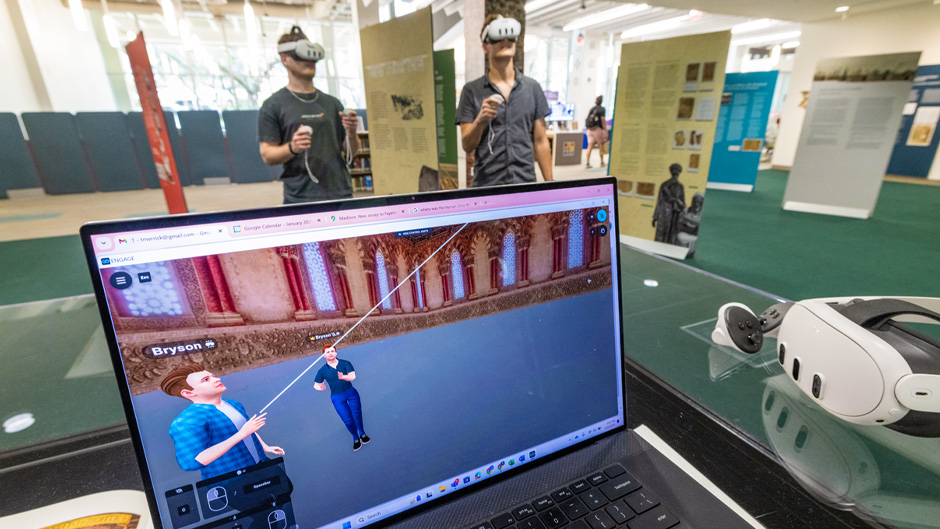Between the 10th and 12th centuries in the region of Al-Andalus (present day Andalucia, Spain), Muslims ruled. For most Jewish people in that region, the period was one of relative prosperity, tolerance, and integration of the three main Abrahamic religions: Islam, Judaism, and Christianity.
The era produced many prominent scholars and thinkers, including Maimonides, a noted rabbi and philosopher who is regarded as one of the most prolific and influential scholars of the Middle Ages. Now, the Otto G. Richter Library at the University of Miami is hosting “The Golden Age of the Jews of Al-Andalus,” an immersive exhibition that brings this extraordinary chapter of history to life.
Organized by Centro Sefarad-Israel and curated by José Martínez Delgado of the University of Granada, the traveling exhibition was brought to the University of Miami by Shai Cohen, in a collaboration with The Sue and Leonard Miller Center for Contemporary Judaic Studies, The George Feldenkreis Program in Judaic Studies, and the University Libraries’ creative team, coordinated by Kineret Ben-Knaan, the director of technical services and subject liaison for Judaic Studies.
The exhibition is open to the public until the end of May at the library’s first floor. The general public is invited to the official launch on Feb. 18 at 4:30 p.m.
The exhibition showcases the intellectual, cultural, and social achievements of Jewish communities in Al-Andalus through a rich collection of artifacts, documents, and interactive experiences. Among the highlights are a 19th-century Torah scroll from the Sephardic community of Tanger, Morocco; a bilingual prayer book, written in Hebrew and Ladino, the language of the Sephardic Jews; prenuptial agreements; children’s homework pages practicing the Hebrew alphabet; and letters discovered in a genizah—a synagogue repository for sacred texts no longer in use.
“The exhibition of ‘The Golden Age of the Jews of Al-Andalus’ is profoundly relevant because it highlights a unique historical moment of intercultural harmony, intellectual achievement, and coexistence,” said Cohen, lecturer of Spanish, Hebrew, and Sephardic studies in the Michele Bowman Underwood Department of Modern Languages and Literatures at the College of Arts and Sciences.
“It is little known, but approximately 120 million Latinos may have Sephardic ancestry, a testament to the far-reaching impact of this community,” he said. “It serves as an antidote to the often polarized and divided narrative of history that focuses primarily on conflict. Instead, while it is important to acknowledge that this period was not without its challenges, it nonetheless demonstrates how Jews, Christians, and Muslims were able to thrive together in the Iberian Peninsula, contributing to shared progress in science, medicine, art, architecture, and philosophy.”
Visitors to the exhibit will be able to enter the world of 12th century Al-Andalus by donning a headset and hand controls that transport them to a meticulously recreated medieval synagogue through a mixed reality experience created by Thomas Merrick, senior project manager for XR Initiatives at the University. A virtual reality experience is also available.
“We created this exhibit so that you can visit it in person or from your home,” said Merrick. “It allows you to interact with an AR agent (avatar) that can explain anything about the exhibit itself.”
The avatar is none other than Maimonides, known in Hebrew as Rambam (an acronym for Rabbi Moses ben Maimon), who is dressed in a long grey robe and black sandals. When asked “Who are you?” the avatar responds with an introduction and follows up with thought-provoking questions like, “What motivates your curiosity about my identity?” and “Are you exploring the intersection of religion and philosophy?”
The answers given by the avatar were generated by AI ChatGPT. But besides giving information about the exhibit, the avatar also acts as the philosopher and guide, encouraging the visitor to think about the implications of what is being presented.
When asked to describe his Mishneh Torah, one of his greatest accomplishments, Maimonides said, “The Mishneh Torah is a comprehensive codification of Jewish law, written in Hebrew. Organized into 14 volumes, it covers a wide range of topics, including laws of prayers, observance of the Sabbath, and ethical conducts.”
In some instances, visitors will also be able to interact with a curator, who, in avatar form will walk them through the exhibit, said Merrick.
Cohen believes that students, scholars, and others who visit the exhibit will gain a great appreciation of how diverse communities can live in relative harmony.
“By exploring this exhibition, visitors can reflect on their own assumptions about identity, coexistence, and the role of culture in bridging divides,” said Cohen. “In essence, the exhibit challenges us to imagine a world where differences enrich rather than divide—a timeless and urgent message.”
The Sephardic Studies Program at the University will continue to use the VR/AI experience after the exhibit concludes, as part of the classes that explore Sephardic heritage and its enduring influence.
